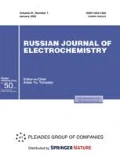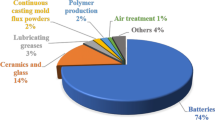Abstract
Electro-activated alkaline (basic) solution known as catholyte has been reported to have a number of unique properties. The changes in the pH and alkalinity of the catholyte were monitored in the current study. A full-factorial design was applied in order to examine the effects of current, time of treatment, and salt concentration on the electro-activated solutions treated in 4 types of configurations. Two configurations were constructed as three-compartment cells with chambers separated by anion exchange membrane (AEM) and cation exchange membrane (CEM) with different dispositions in the cell. The other two configurations were two-compartment cells with chambers separated by either an AEM or a CEM. For pH increase, time was the most significant factor, whereas for the alkalinity the cell configuration had a significant impact. Thus, when CEM was used to separate central and cathodic compartments in a three-cell reactor, or anodic and cathodic compartments in a two-cell reactor only current and time were found to be highly significant. On the other hand, when the AEM was used the salt concentration appeared to be an important factor too. Maximum values for pH (pH 12) and alkalinity (25.46 ± 0.31 mmol/L) were obtained after 60 min of treatment and 0.2 A current, and regardless of NaCl concentrations when CEM was used, whereas maximum values for the AEM membrane were achieved only with maximum NaCl concentration of 1 M. Despite highly alkaline medium (pH ~ 12) the strength of the solution was comparable to dilute NaOH solution (~0.03 M).





Similar content being viewed by others
REFERENCES
Bogatova, O.V. and Bogatov, A.I., Study of electro-activated aqueous solutions and their use in the poultery industry, Vestn. Orenburg.Gos. Univ., 2003, vol. 3, p. 151.
Chaplin, M., Water structure and science. http://www1.lsbu.ac.uk/water/electrolysis.html. Accessed 10.12.2016.
Pang, X. and Deng, B., Investigation of changes in properties of water under the action of a magnetic field, Sci. China Phys., Mech. Astron., 2008, vol. 51, p. 1621.
Cai, R., Yang, H., He, J., and Zhu, W., The effects of magnetic fields on water molecular hydrogen bonds, J. Mol. Struct., 2009, vol. 938, p. 15.
Cardella, C., De Magistris, L., Florio, E., and Smith, C.W., Permanent changes in the physico-chemical properties of water following exposure to resonant circuits, Sci. Explor., 2001, vol. 15, p. 501.
Aider, M., Gnatko, E., and Benali, M., Electro-activated aqueous solutions: theory and application in the food industry and biotechnology, Innovative Food Sci. Emerg. Technol., 2012, vol. 15, p. 38.
Huang, Y.-R., Hung, Y.-C., and Hsu, S.-Y., Application of electrolyzed water in the food industry, Food Control, 2008, vol. 19, p. 329.
Rahman, S.M.E., Ding, T., and Oh, D.-H., Effectiveness of low concentration electrolyzed water to inactivate foodborne pathogens under different environmental conditions, Int. J. Food Microbiol., 2010, vol. 139, p. 147.
Kiura, H., Sano, K., and Morimatsu, S., Bactericidal activity of electrolyzed acid water from solution containing sodium chloride at low concentration, in comparison with that at high concentration, J. Microbiol. Methods, 2002, vol. 49, p. 285.
Aït Aissa, A. and Aïder, M., Ion exchange membranes controlled electro-catalytic synthesis of lactulose from lactose under refrigerated conditions, Innovative Food Sci. Emerg. Technol., 2013, vol. 20, p. 299.
Bazinet, L., Electrodialytic phenomena and their applications in the dairy industry: a review, Crit. Rev. Food Sci. Nutr., 2005, vol. 44, p. 525.
Tomilov, A.P., Electrochemical activation: a new trend in applied electrochemistry, Life Safety, 2002, vol. 3, p. 302.
Hsu, S.-Y., Effects of flow rate, temperature and salt concentration on chemical and physical properties of electrolyzed oxidizing water, J. Food Eng., 2005, vol. 66, p. 171.
Mani, K.N., Electrodialysis water splitting technology, J. Membr. Sci., 1991, vol. 58, p. 117.
Baker, R.W., Membrane Technology and Applications, John Wiley & Sons, 2012, p. 417.
Shaposhnik, V.A., Evolution of the membrane electrochemistry, Russ. J. Electrochem., 2002, vol. 38, p. 800.
Maevskaya, T.N. and Babkov, N.I., Study of electro-activated solutions and use in the fish protein production industry, Food Sci. Technol. (Odessa, Ukraine), 2012, vol. 1, no. 18, p. 99.
Pastukhov, V.I. and Morozov, V.P., Raman scattering of light by the electroactivated water, Opt. Spectrosc., 2000, vol. 88, p. 35.
Damaskin, B.B., Petrii, O.A., and Tsirlina, G.A., Electrochemistry, Moscow: Khimiya, 2008.
Tanaka, Y., Water dissociation reaction generated in an ion exchange membrane, J. Membr. Sci., 2010, vol. 350, p. 347.
Belovolova, L.V., Glushkov, M.V., and Vinogradova, G.I., Fluorent Characteristics of Water Activated by Electrolysis. The Role of Active Forms of the Hydrogen, 2006.
ACKNOWLEDGMENTS
The authors are thankful to Mrs. Diane Gagnon for the technical assistance in the laboratory.
Funding
This work was financially supported by the innovation in food support program that was funded by contracts through the “Growing Forward” Program that occurred between the Ministere de l’agriculture, des pecheries et de l’alimentation du Quebec (Ministry of Agriculture, Fisheries and Food of Quebec) and “Agriculture and Agri-Food Canada”.
Author information
Authors and Affiliations
Contributions
The authors of this article have equally contributed to the realisation all the steps of this work.
Corresponding authors
Ethics declarations
The authors declare that they have no conflict of interest.
Rights and permissions
About this article
Cite this article
Gerzhova, A., Aider, M. Alkalinity of Electro-Activated Aqueous Solutions. Russ J Electrochem 56, 243–253 (2020). https://doi.org/10.1134/S1023193520010048
Received:
Revised:
Accepted:
Published:
Issue Date:
DOI: https://doi.org/10.1134/S1023193520010048




